Daggett & Ramsdell
V. Chapin Daggett was born in South Weymouth, Massachusetts. After graduating from the Massachusetts College of Pharmacy in 1885 he moved to New York to work as a druggist. In 1890, he formed a partnership with another graduate of the Massachusetts College of Pharmacy, Clifford Ramsdell [1858-1911] to open a drug store at 325 Fifth Avenue, New York. From this modest beginning Daggett & Ramsdell grew into an international American brand, primarily through the development of a new cold cream.
Perfect Cold Cream
Nineteenth century pharmacists were very familiar with cold creams formulated from beeswax, almond oil and rosewater. Although popular, the creams had a short shelf life so pharmacists only made them up in small quantities for sale to local customers.
At some stage Daggett substituted petroleum jelly for the almond oil, which stopped the cream from going rancid, and added borax to the mix which improved the stability of the emulsion. Together these two innovations produced a cold cream with a long shelf life that could be manufactured on an industrial scale and shipped to distant places. Branded as Daggett & Ramsdell’s Perfect Cold Cream, early company advertising described it as ‘The only kind that keeps’.
In every country where daintiness of the toilet is recognized as a mark of refinement, Daggett & Ramsdell’s Perfect Cold Cream is known and renowned as the most delightful and meritorious of all toilet accessories. This popularity is due to its unvarying quality, it’s free from harmful ingredients and the fact that it NEVER BECOMES RANCID.
In this respect it is different from and superior to all other creams. It is not affected by heat, cold or climatic changes. It does not lose its snowy whiteness, its delicate perfume or its wonderful skin-cleansing properties which have given it international fame.(Daggett & Ramsdell, 1911, p. 14)
Substituting petroleum jelly for almond oil in a cold cream and adding borax were not original ideas. Robert Augustus Chesebrough [1837-1933] had developed a petroleum-based Vaseline Cold Cream in 1876 and the idea of adding borax had been suggested by Adolf Vomácka [1856-1919] in 1883. However, Daggett & Ramsdell was the first American firm to manufacture this type of cold cream on an industrial scale and sell it across the nation.
See also: Cold Creams and Petrolatum/Petroleum Jelly
Exactly when Daggett developed his Perfect Cold Cream is difficult to ascertain. Company advertising consistently refers to it being introduced in 1891 but trademark documents suggests that it was not sold as Perfect Cold Cream until 1893.

Above: 1919 Perfect Cold Cream jar and box. The packaging design was first used in 1895 but the horizontal bar surrounding the cold cream label dates from 1900.
Daggett & Ramsdell claimed that its cold cream dissolved dirt and grime from the pores which prevented skin blemishes; replaced the emollients removed by washing with soap which kept the skin soft; and when massaged in kept the skin supple and reduced wrinkles; all claims common to cold creams of the time.
Also see: Massage, Wrinkles and Double Chins
Daggett & Ramsdell thought massage to be particularly beneficial and the firm provided instructions for specific massage routines for various parts of the face as well as the neck, arms and shoulders.
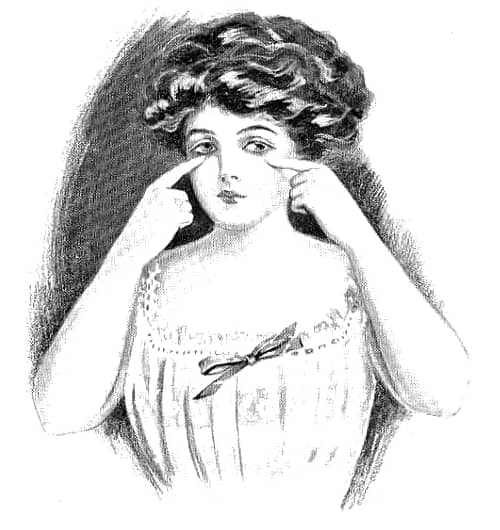
Above: 1908 Daggett & Ramsdell Massage Lesson No. 3 for the removal of lines and crow’s feet beneath the eyes.
Also see the 1911 company booklet: Daggett & Ramsdell’s Perfect Cold Cream
Incorporation and expansion
In 1896, the partnership between Daggett and Ramsdell was dissolved with Ramsdell selling his interest in the firm to Henry M. O’Neil. The dissolution of the partnership appears to have been amicable as Daggett, Ramsdell and O’Neil later entered into other business arrangements.
In 1897, the firm moved its pharmacy and associated operations to a four-storey building at 17 West 34th Street, opposite the Waldorf-Astoria, gaining much needed space, and then, in 1898, Daggett & Ramsdell incorporated (capital US$50,000) with Henry M. O’Neil as the company president and V. Chapin Daggett as secretary and treasurer.
The business continued to expand after its incorporation. In 1902, a new laboratory was developed at 211 West 32nd Street with Augustus. G. Shoppach [1874-1961] in charge. In 1905, Daggett & Ramsdell opened a booth in the Waldorf-Astoria becoming the first pharmacy operating in a New York hotel.
In 1907, the company closed its retail operations so that it could concentrate on manufacturing and promoting its proprietary lines and as part of this change in direction it erected and occupied a five-storey building at 314 West 14th Street, New York. The following year it began a national advertising campaign to sell its products across the United States. The company also began exporting its products starting with Canada no later than 1907. In 1908, its depots were as follows: Muller, Maclean & Co., London, England; J. Palmer & Son, Montreal, Canada; Samuel T. fletcher & Co., Paris, France; Theodor Lenk, Berlin, Germany; Geo. Bauman, Dresden, Germany; J. Comein, Antwerp, Belgium; Benson, Smith & Co., Honolulu, Hawaii; H. Roberts & Co., Rome, Florence and Milan, Italy; Dr. Manuel Johnson, Havana, Cuba; Sanborn Bros., Mexico City, Mexico; J. H. Bradley & Co., Hamilton, Bermuda; J. Llewellyn & Co., Shanghai, China; S. J. Betines & Co., Tientsin (Tianjin), China; Fitch & Co., Mussoorie, India; and Columbo Apothecaries Co., Columbo, Ceylon (Sri Lanka). Others followed and by 1917 Daggett & Ramsdell products were being sold as far away as Australia.
Products
As well as Perfect Cold Cream, Daggett & Ramsdell produced a number of other products in its Perfect Toilet Line: Perfect Cold Cream Soap (1902), Perfect Cold Cream Shaving Stick (1905), Headache Cologne (a mentholated cologne) later renamed Ha-Kol, and Violette Rico Toilet Water (1911).
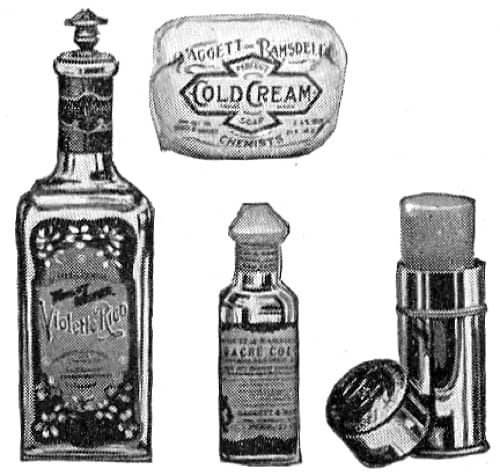
Above: 1911 Daggett & Ramsdell Perfect Cold Cream Soap, Violette-Rico Toilet Water, Headache Cologne, and Perfect Cold Cream Shaving Stick.
Perfect Cold Cream Soap: “Made of the finest materials only and having a large sale among those who appreciate its very superior quality.”
Perfect Cold Cream Shaving Stick: “Its superiority is acknowledged by discriminating self-shavers who use only the best and have learned to depend on its unvarying quality. in a handsome nickel box.”
Headache Cologne: “A delightful and refreshing application, affording prompt relief in headaches, neuralgic pain or nervous irritability.”
Violette-Rico Toilet Water: “Not surpassed by any other toilet water, either domestically or imported, now on the market.”
The company also added two face powders, a cheaper Poudre Debutante (1913) and a more expensive Poudre Amourette (1916), both in Flesh (Pink), White, and Brunette (Cream) shades.
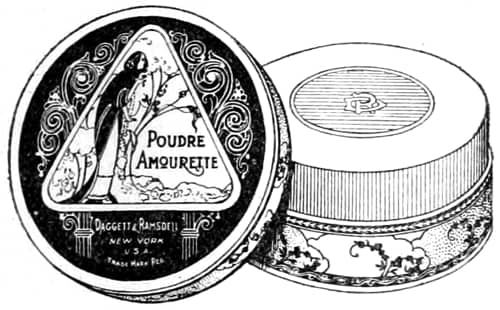
Above: Daggett & Ramsdell Poudre Amourette.
In 1916, Daggett & Ramsdell purchased 214-216 West 14th Street, New York, erected an eight-storey factory and office building on the site and occupied the first five floors of the building.
The company did good business through to the end of the 1910s but things became more precarious during the 1920s. Although Daggett & Ramsdell sold a small range of cosmetics it remained primarily a one product company and this became more and more of a problem. Despite the favourable economic conditions that flowed after the post-war depression of 1921-1922 Daggett & Ramsdell failed to adjust to a beauty market that was becoming increasingly sophisticated.
A major competitor for Perfect Cold Cream was Pond’s Cold Cream, introduced in 1904 along with Pond’s Vanishing Cream. Pond’s had increased its market share in the 1920s through its ‘Every skin needs two creams’ campaign which it started in 1916 – an early example of a skin-care system.
Also see: Pond’s Extract Company
Daggett & Ramsdell was slow to do something similar, only adding Perfect Vanishing Cream in 1925. The company went on to add Vivatone skin tonic and Perfect Cleansing Cream in 1929 but by then the company’s early promise had largely evaporated.
Standard Oil
In 1929, Daggett & Ramsdell was absorbed by the Standard Oil Company in a stock swap estimated to be worth about US$1.5 million. This was not Standard Oil’s first venture into the beauty business: it had previously owned the Chesebrough Manufacturing Company, the makers of Vaseline.
See also: Chesebrough Manufacturing Company
Under the stock swap the 2950 shares of Daggett & Ramsdell – consisting of 1,425 shares owned by the estate of Henry M. O’Neil, 1,425 shares held by V. Chapin Daggett, and 100 shares possessed by Augustus V. Shoppach – were exchanged for 30,928 shares of Standard Oil. Daggett, Shoppach and the O’Neil heirs did quite well out of the deal as it was finalised before the stock market crash of 1929.
Joining Standard Oil initiated a major reorganisation of Daggett & Ramsdell. The company offices were moved to 2 Park Avenue, New York and the distribution of its products was taken over by Stanco Distributors, Inc., a Standard Oil subsidiary.
Standard Oil also updated Daggett & Ramsdell’s image and broadened its product range. Late in 1929, a new logo was introduced and then the following year – to mark the 40th anniversary of the founding of the business – the entire Daggett & Ramsdell product line was repackaged.
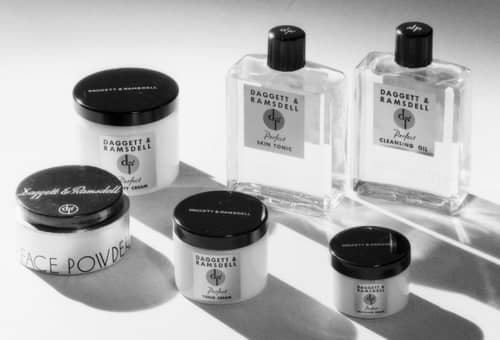
Above: 1934 Assorted Daggett & Ramsdell cosmetics in new packaging in white porcelain jars and clear glass containers with silver monograms on grey labels.
The company also opened demonstration beauty salons at 62 East Monroe Street, Chicago (1933) and Shop 8, 30 Rockefeller Plaza, New York (1935) to help promote the sale of its products in stores. These salons were solely for demonstration purposes so only a nominal treatment fee was charged.
Skin-care
In 1930, Daggett & Ramsdell had four products in its skin-care range – Perfect Cold Cream (1893), Perfect Vanishing Cream (1925), Vivatone (1929) and Perfect Cleansing Cream (1929). Together, these gave the company a basic skin-care system.
First: Apply Daggett & Ramsdell’s Perfect Cleansing Cream liberally. It liquefies instantly. Cleanses quickly. Wipe off with tissues.
Second: Apply Daggett & Ramsdell’s Perfect Cold Cream and massage gently but thoroughly. Brings new life to the tissues. Stimulates the circulation. Wipe off with tissues.
Third: Wet pad with Vivatone and slap the face sharply with it to close pores, invigorate the skin and remove surplus cream.
Fourth: Apply a whisk of Perfect Vanishing Cream before your make-up. Result: Youth! Freshness! Beauty!(Daggett & Ramsdell advertisement, 1930)
Other skin-care lines added in the early 1930s included: Perfect Beauty Cream and Perfect Tissue Cream (1933); and Perfect Liquefying Cream, Perfect Cleansing Oil and Perfect Hand Lotion (1934). Some existing products were also renamed to include them in the Perfect range, e.g., Vivatone was renamed as Perfect Skin Tonic: others disappear, e.g., Perfect Vanishing Cream. However, these changes were not universally applied across all overseas markets.
Perfect Beauty Cream: “unexcelled as a cleanser for dry skin.”
Perfect Liquefying Cream: “softens and removes every trace of surface dirt, dust and make-up in record time.”
Perfect Tissue Cream: “rich in soothing and nourishing oils, to keep the thin dry skin supple and young.”
Perfect Cleansing Oil: “recommended for women who prefer a liquid for cleansing.”
Perfect Hand Lotion: “rosy-clear liquid lotion that prevents chapping and whitens your hands.”
See also: Liquefying Cleansing Creams
Daggett & Ramsdell also added Sun Brown Oil (1933) and Sun Lotion (1935) for visits to the beach.
Sun Brown Oil: “the comfortable way to a perfect tan.”
Sun Lotion: “Protect your skin against the dangerous burning and blistering of the sun, meanwhile acquiring a luscious golden tan!”
The addition of new skin-care products allowed Daggett & Ramsdell to provide morning and night routines for the three traditional skin types – normal, oily and dry.
Dry Skin
Night:
Cleanse with Perfect Beauty Cream.
Tone with Perfect Skin Tonic.
Soothe with Perfect Tissue Cream.
Morning:
Cleanse with Perfect Beauty Cream.
Tone with Perfect Skin Tonic.
Oily Skin
Night:
Cleanse with Perfect Liquefying Cream.
Wash with Perfect Cold Cream Soap.
Tone with Perfect Skin Tonic.
Apply Perfect Beauty Cream.
Morning:
Wash with Perfect Cold Cream Soap.
Rinse with warm water.
Tone with Perfect Skin Tonic.
Normal Skin
Night:
Cleanse with Perfect Beauty Cream.
Wash with Perfect Cold Cream Soap.
Tone with Perfect Skin Tonic.
Apply Perfect Tissue Cream.
Morning:
Wash with Perfect Cold Cream Soap.
Tone with Perfect Skin Tonic.
In 1935, Daggett & Ramsdell introduced Elorda Cream and Elorda Revitalizer Cream in squat, black bottles. Both products were advertised as containing gold which was said to ‘increase the cleansing and revitalising action of the preparations many fold’. The reference to gold may explain the use of the Elorda name as it is similar to Eldorado. The following year Daggett & Ramsdell added Golden Cleansing Cream also containing colloidal gold.
These products brought Daggett & Ramsdell into conflict with the Federal Trade Commission (FTC) after the passing of the 1938 Food, Drug and Cosmetic Act (FD&CA). In 1938, the FTC forced Daggett & Ramsdell to stop advertising that these preparations “would seep into the skin and dislodge and eliminate waste matter, dead tissue cells or other impurities, keep the skin beautifully soft and youthful or have any effect on enlarged pores, lines or wrinkles” (American Medical Association, 1941, p. 30).
Make-up
A major change in the Daggett & Ramsdell product range took place in 1933 when the company introduced a complete line of make-up. This consisted of: Perfect Face Powder in Naturelle, Naturelle No. 2, Rachel No. 2, Brunette and Brunette No. 2 shades; Perfect Lipstick in Light, Medium and Raspberry shades; Perfect Cream Rouge and Perfect Cake Rouge, also in Light, Medium and Raspberry shades; Perfect Eye Pencil in Brown and Black shades; and Perfect Eye Shadow in Blue-Gray and Brown shades. The make-up range also included: Protective Cream, a foundation; and Finishing Lotion, a liquid powder for the neck, shoulders and arms. Both of these products came in Naturelle, Rachel and Brunette No. 2 shades.
Shades of Daggett & Ramsdell make-up were coordinated with a woman’s hair, skin and eye colour and the company provided shade suggestions for eight broad colour types: Light Blonde, Medium Blonde, Dark Blonde, Titian Blonde, Light Brunette, Medium Brunette, Titian Brunette, and Dark Brunette.
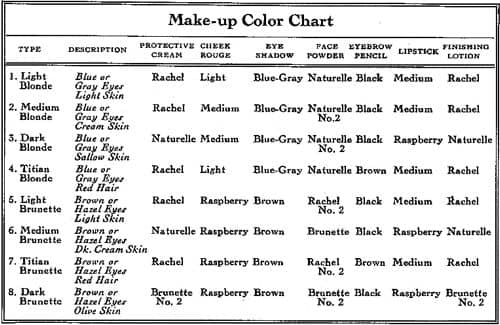
Above: 1934 Daggett & Ramsdell make-up colour chart.
See also: Make-up, Personality and Types
Daggett & Ramsdell used these types when it introduced its Park Avenue Make-up Kits in 1936. There were eight kits, one for each type, each with a picture of a woman representing the type on the cover of each box. The kits contained Perfect Protective Cream, Perfect Skin Tonic, Perfect Face Powder, Perfect Cream Rouge, Perfect Lipstick, Perfect Finishing Lotion, Perfect Eyeshadow and Perfect Eyebrow Pencil with shades of make-up appropriate for each type.
Also see the 1934 company booklet: Tuning in with Beauty
In 1940, to celebrate its 50th anniversary, the company repackaged its products once more, in a style that looked back to the 1890s when the company was founded. This design decision may have been influenced by the success Shulton had achieved with its Early American Old Spice range (1937) which was packaged in colonial inspired containers.
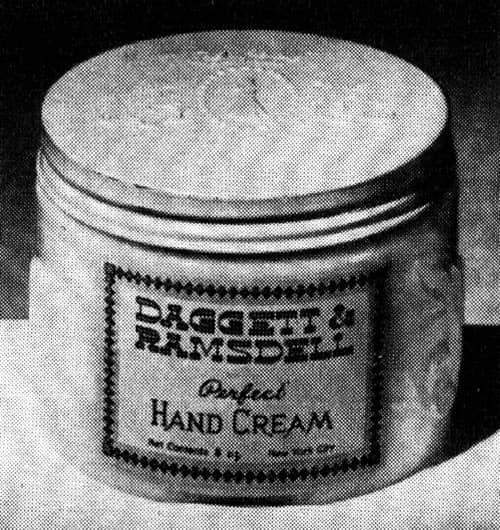
Above: 1944 Daggett & Ramsdell Perfect Hand Cream packaged in an 1890s style designed by Everett W. King.
See also: Shulton
In 1940, Daggett & Ramsdell released three products scented with Mountain Heather fragrance – Mountain Heather Cologne, Mountain Heather Bath Powder, and Mountain Heather Talc – packaged in pink containers decorated white heather bell flowers and blue ribbons.
Wartime
During the Second World War the company introduced Débutante Make-up (1942), a pancake make-up in Natural, Rachel and Deep Peach shades with Rose Brunette added in 1943. Like Max Factor’s Pancake Make-up (1938) it was applied with a moist sponge. The product was complemented with Débutante Lipstick in Cherry, Red Rose and Geranium shades.
Débutant Make-up: “A cake form of make-up that is so easily applied with a moistened sponge. Immediately gives your skin a smooth, velvety appearance. You’ll also find it excellent for concealing minor skin blemishes.”
Also see: Pan-Cake Make-up
Daggett & Ramsdell also added to its Mountain Heather range with Mountain Heather Soap (1942), Mountain Heather Face Powder in Rachel, Rose Brunette, Brunette, Naturelle and Peach shades, and Mountain Heather Cake Make Up (1945).
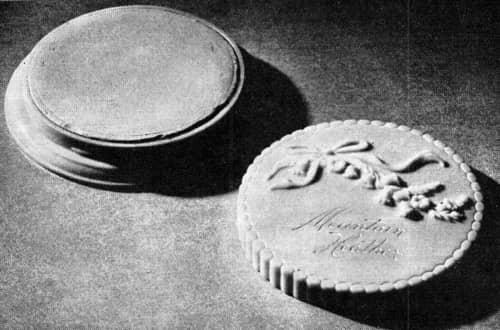
Above: 1945 Mountain Heather Cake Make-up in an embossed pink compact case.
Other new products included Leg Make-up (1942) and Perfect Deodorant Cream which used aluminium sulphate as the active ingredient.
Leg Make-up: “It smooths on your legs in almost nothing flat, helps hide small blemishes, looks glamorous! Try it—save stockings . . . feel cool . . . look smart!”
Perfect Deodorant Cream: “Smooth-textured, delicately scented . . . helps check underarm odor and perspiration. Keep dainty and fresh all the year round”.
Post-war
After the war, Daggett & Ramsdell launched a complete Débutante range for younger women aged between 16 and 29. The line was launched in 1947 in the Cotillion Room at the Pierre hotel in New York packaged in cornflower-blue containers embellished with prints of red roses.
Skin-care lines in the Débutante range included: Débutante Beauty Cream and Débutante Beauty Lotion, both used as skin cleansers; Débutante Skin Freshener, a skin tonic; and Débutante Special Formula, a tinted soothing lotion for minor skin blemishes. Using these cosmetics, skin-care regimes were developed for Normal, Dry, Oily, Problem and Combination skin.
Débutante make-up included: Débutant Lipstick, Débutante Rouge and Débutante Nail Polish in matching Natural, Misty Rose, Blush Pink, Bright Red, Jewel Red, Orchid Rose, Spice Red and Evening Rose shades; Débutante Make-up Lotion in Blush Pink, Pale Gold, Rose Cream, Rosy Dusk, Golden Spice, Holiday Tan and Bronze shades matched shade for shade with Débutante Face Powder; Débutante Eye Shadow in Blue, Green, Violet, Brown and Gray shades; Débutant Mascara in Indigo, Sepia and Ebony shades; and Débutante Eyebrow Pencil in Black and Brown shades.
Other items in the range included: Débutante Soap, Débutante Bubble Bath, Débutante Bath Powder, Débutante Talc, Débutante Foamy Powder Shampoo, Débutante Hand Lotion and Débutante Deodorant Cologne.
Débutante Beauty Cream: “a fine, fluffy cleanser that leaves the skin fresh as a flower.”
Débutante Make-Up Lotion: “a creamy-smooth tinted lotion that lends a petal finish softness.”
Débutante Skin Freshener: “a pleasant, tingling refresher that helps to ‘wake up’ the skin.”
Débutante Face Powder: “a delicately fragrant and clinging, petal soft finishing touch.”
Débutante Cake Mascara: “dramatizes your eyes and emphasizes their natural depth and beauty.”
Débutante Lipstick: “accents your charming smile with glowing, long remaining clear color.”
Débutante Beauty Lotion: “a delicately fragrant creamy lotion that cleanses quickly.”
Débutante Cake Rouge: “light in texture and comes in shades to enhance your own coloring.”
In 1947, Daggett & Ramsdell launched a men’s toiletry line which included: Soap, Lather Shaving Cream, Shave Bowl, After Shave Lotion, Foamy Powder Shampoo, Talcum Powder, and Hair Lotion.
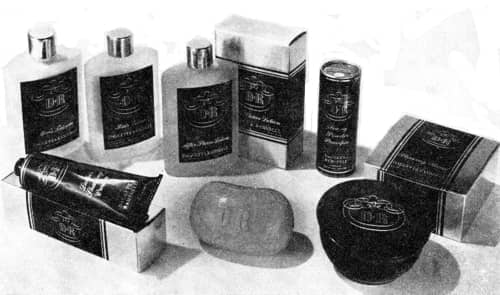
Above: 1947 Daggett & Ramsdell’s men’s toiletries in frosted bottles finished with gold metal lids along with ebony and gold tubes.
Special mention should also be made of Daggett & Ramsdell’s Gay Manhattan (1946) an early aerosol discontinued in 1948.
See also: Aerosol Cosmetics
Sale
In 1948, Standard Oil sold Daggett & Ramsdell to a group of investors made up of: William J. Perridge, previously with Conti Products Corporation, who became the company president; Arthur J. Weglein, president of the Draper Soap Company; John J. Hardy, formerly with Prince Matchabelli; and Joseph J. Fischer, C.P.A., who took up the position of company treasurer.
Almost immediately the group came to an agreement with the Fuller Brush Company – founded in 1906 by Alfred C. Fuller [1885-1973] – whereby Fuller Brush would sell Daggett & Ramsdell’s Débutante range door-to-door. The hope was that Fuller Brush would emulate some of the success experienced by Avon. Most existing Fuller agents were men so women, known as Fullerettes, were hired to demonstrate and sell the line house-to-house.
In 1952, to help reduce costs, Daggett & Ramsdell entered into an arrangement with the Zonite Products Corporation – the makers of Zonite antiseptic and Forhan’s toothpaste – in which the two firms agreed to merge their sales forces.
Fuller Brush
As well as the Débutante range – which later also came scented with Mystic Moment fragrance – Daggett & Ramsdell also sold other cosmetic lines – including Juvené, Sparkling Gold and Youth Glow – through Fuller Brush, along with toiletries for men.
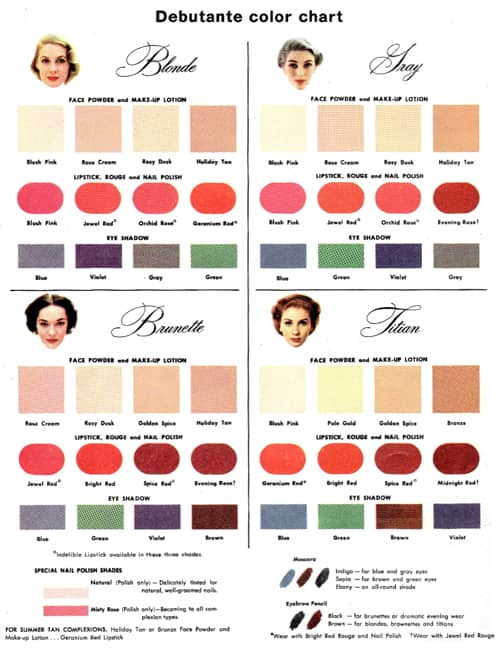
Above: Debutante colour chart as used by the Fuller Brush Company.
I do not know exactly how long the relationship between Daggett & Ramsdell and Fuller Brush lasted but it is likely that it came to an end just before the merger of Daggett & Ramsdell with the Barcley Corset Company in 1958. Fuller Brush continued to sell cosmetics after this but it appears that these were from a private provider.
Later developments
The new entity created by the merger between Daggett & Ramsdell and Barcley Corset was named Daggett & Ramsdell, Inc. It hoped to provide the American woman with a ‘complete beauty service for both her face and figure’. As well as Daggett & Ramsdell cosmetics the company also owned the Primrose House line which Daggett & Ramsdell had secured in 1955, three years before the merger.
See also: Primrose House
The company sold its products through drug stores but sales must have been disappointing as it tried unsuccessfully to set up its own door-to-door sales business in 1962. That year also saw the separation of the foundation and garment businesses from the cosmetics operations of Daggett & Ramsdell when Exquisite Form Industries, Inc. bought the corset and brassiere components. The cosmetic business continued on until 1995, when Daggett & Ramsdell was purchased by Fisk Industries, Inc. who continue to sell Daggett & Ramsdell cosmetics to this day.
Timeline
| 1890 | V. Chaplin Daggett and Clifford Ramsdell open a drug store at 325 Fifth Avenue, New York. |
| 1893 | New Products: Perfect Cold Cream. |
| 1896 | Daggett & Ramsdell partnership dissolved. |
| 1897 | Moved to larger four-storey building at 17 West 34th Street. |
| 1898 | Daggett & Ramsdell incorporates. |
| 1902 | Laboratory opened at 211 West 32nd Street. New Products: Perfect Cold Cream Soap. |
| 1905 | Open prescription and toiletry departments at the Waldorf-Astoria. New Products: Perfect Cold Cream Shaving Stick. |
| 1907 | Daggett & Ramsdell cease retail trading. |
| 1908 | Building erected at 314 West 14th Street. |
| 1913 | New Products: Poudre Debutante. |
| 1915 | New Products: Poudre Amourette. |
| 1917 | New building erected at 214-216 West 14th Street. |
| 1925 | New Products: Perfect Vanishing Cream. |
| 1929 | Daggett & Ramsdell bought by Standard Oil Company. New Products: Dagelle cosmetics line; Perfect Cleansing Cream; and Vivatone. |
| 1930 | Headquarters moved to 2 Park Avenue, New York. Product line repackaged. |
| 1933 | Salon opened 62 East Monroe Street, Chicago. New Products: Perfect Beauty Cream; Perfect Tissue Cream; Sun Brown Oil; Perfect Face Powder; Perfect Lipstick; Perfect Cream Rouge; Perfect Cake Rouge; Perfect Eye Pencil; Perfect Eye Shadow; Protective Cream; and Finishing Lotion. |
| 1934 | New Products: Perfect Liquefying Cream; and Perfect Cleansing Oil. |
| 1935 | Salon opened at 30 Rockefeller Plaza, New York. New Products: Sun Lotion; Elorda Cream; and Elorda Revitalizer Cream. |
| 1936 | New Products: Golden Cleansing Cream. |
| 1937 | New Products: Sonata fragrance. |
| 1940 | Product line repackaged. New Products: Mountain Heather Cologne; Mountain Heather Bath Powder; and Mountain Heather Talc. |
| 1942 | Lease taken out on the building at 719-723 Greenwich Street, New York. New Products: Débutante Make-up; and Mountain Heather Toilet Soap. |
| 1943 | Daggett & Ramsdell begin selling cosmetics in plastic containers. |
| 1946 | Gay Manhattan, an aerosol perfume. |
| 1947 | New Products: Débutante line for young adults; and a men’s line of toiletries. |
| 1948 | Daggett & Ramsdell bought by an investment group headed by William J. Perridge. Débutante line sold through the Fuller Brush Company. New Products: Débutante Foamy Powder Shampoo. |
| 1950 | New Products: Gay Manhattan cosmetics line. |
| 1952 | Daggett & Ramsdell merges its sales force with Zonite Products Corporation. |
| 1953 | New Products: Perfect Deodorant Cream; and Perfect Oil Shampoo. |
| 1955 | Daggett & Ramsdell take over the manufacture, sale and distribution of Primrose House cosmetics. |
| 1958 | Daggett & Ramsdell merges with the Barcley Corset Company. |
| 1960 | New Products: Greenbrier men’s line. |
| 1962 | The corset and brassiere subsidiaries of Daggett & Ramsdell bought by Exquisite Form Industries, Inc. |
| 1995 | Daggett & Ramsdell bought by Fisk Industries, Inc. |
Updated: 13th May 2018
Sources
American Medical Association. (1941). A review of some of governmental agencies and other information on cosmetics, 1930-1940. Chicago, IL: Author.
Daggett & Ramsdell. (1911). Daggett & Ramsdell’s perfect cold cream [Booklet]. Philadelphia, PA: Wolf & Co.
Daggett & Ramsdell. (1934). Tuning in with beauty [Booklet]. USA: Author.
The national cyclopedia of American biography. (1939). Volume XXVII. New York: James T. White & Company.

Volney Chapin Daggett [1859-1943].
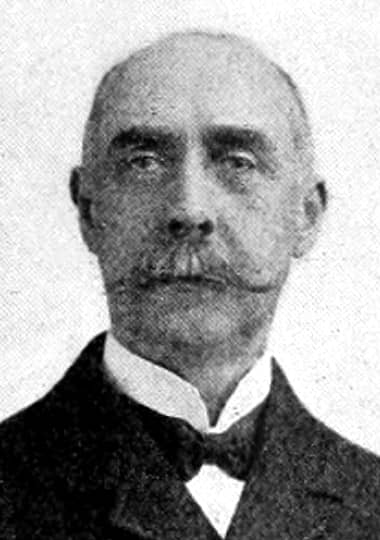
Henry M. O’Neil [1850-1922] . After graduating from the New York School of Pharmacy in 1875 he went into business for himself becoming the owner of a succession of drug stores as well as the Crescent Drug Company, Inc. – the makers of Crescent Sarsaparilla – which he sold in 1895. He remained the president of Daggett & Ramsdell until at least 1920.
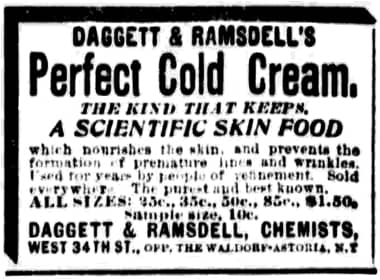
1900 Daggett & Ramsdell Perfect Cold Cream.
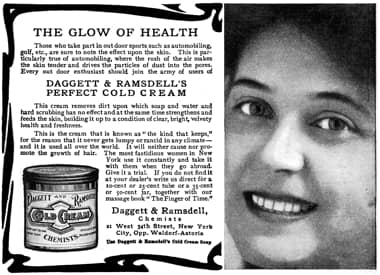
1905 Daggett & Ramsdell Perfect Cold Cream.
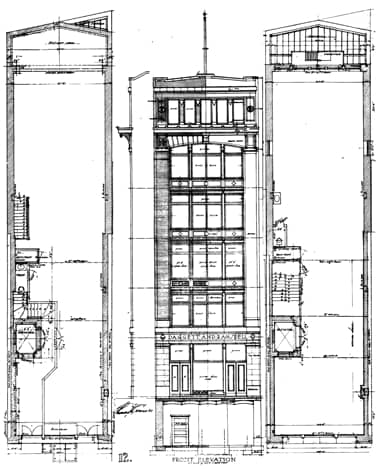
Plans for the Daggett & Ramsdell building at 314 West 14th Street, New York designed by the architects Arno Kolbe [1880-1942] and Gregory B. Webb [1878-1948]. The building still stands today.
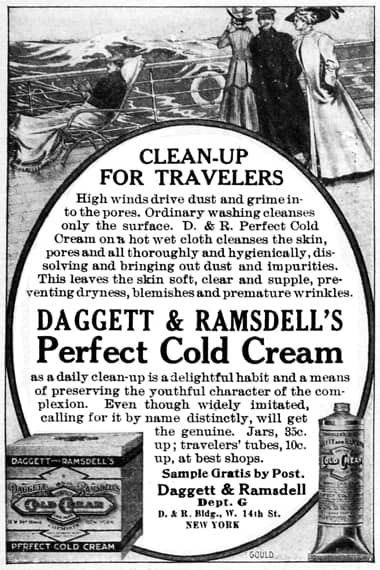
1909 Daggett & Ramsdell Daggett & Ramsdell Perfect Cold Cream in jar and tube.
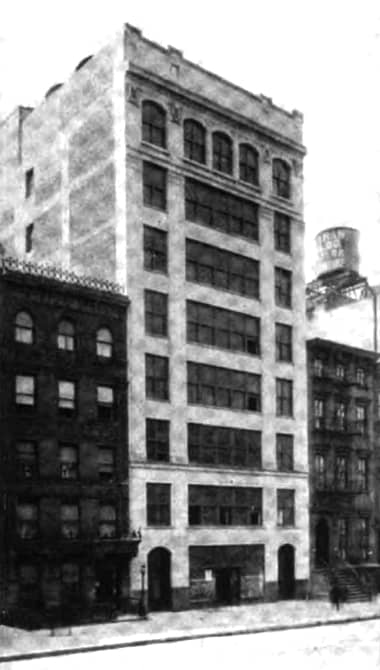
1917 Eight-storey factory and office building erected by Daggett & Ramsdell at 214-216 West 14th Street, New York designed by the architectural firm of Timmis & Chapman and built by the Turner Construction Company. The building still stands today.
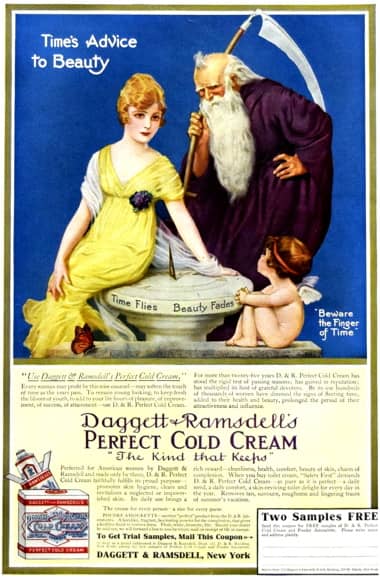
1917 Daggett & Ramsdell Perfect Cold Cream.
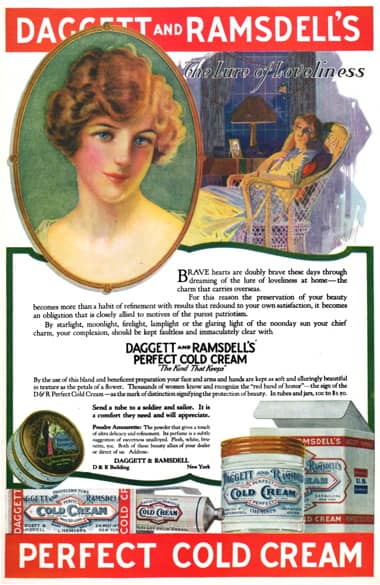
1919 Daggett & Ramsdell Perfect Cold Cream and Poudre Amouretta.
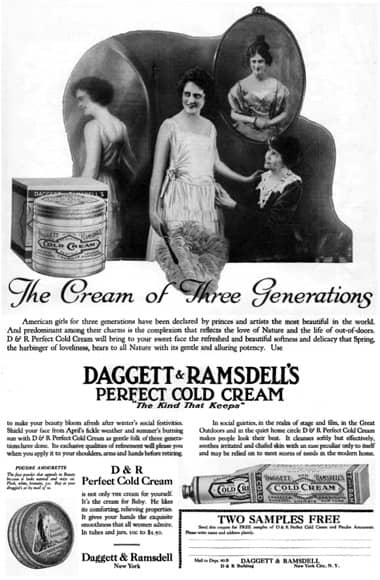
1920 Daggett & Ramsdell Perfect Cold Cream and Poudre Amoretta.
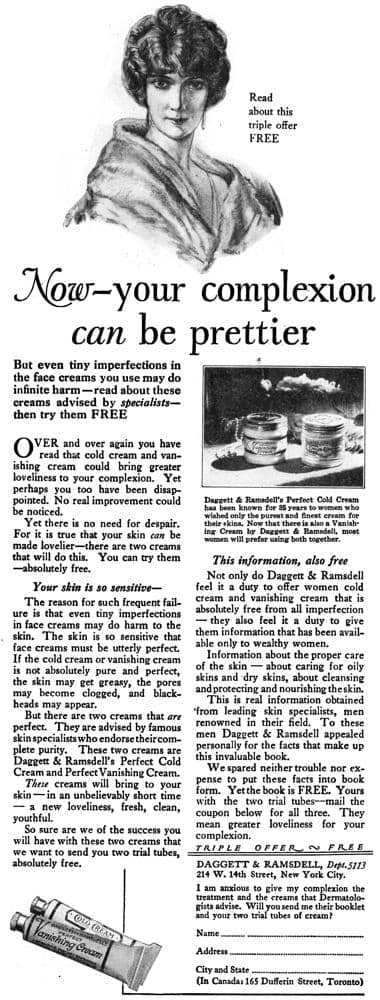
1925 Daggett & Ramsdell Perfect Cold Cream and Perfect Vanishing Cream.
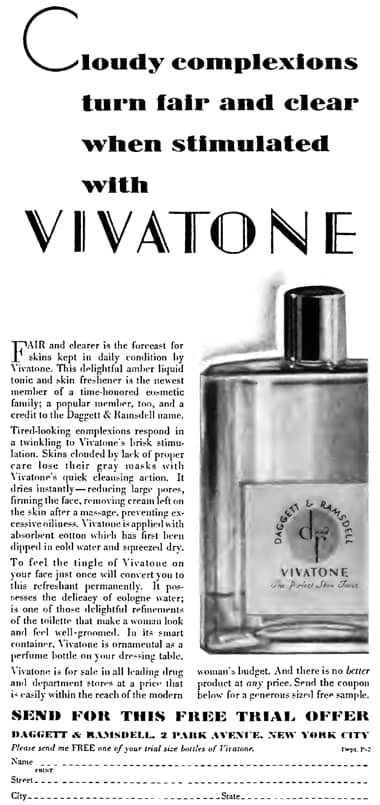
1931 Daggett & Ramsdell Vivatone.
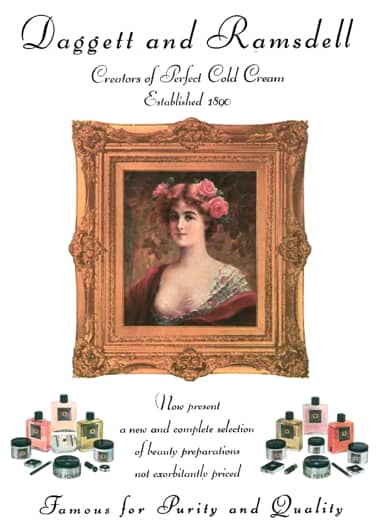
1934 Daggett & Ramsdell.
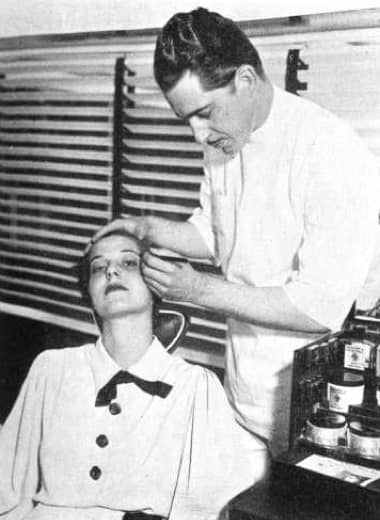
1934 Durel Dugas conducts a make-up demonstration at the 1934 World’s Fair using the new Daggett & Ramsdell make-up range introduced in 1933. The model is Patricia Marquahn, the Century of Progress Beauty Queen.
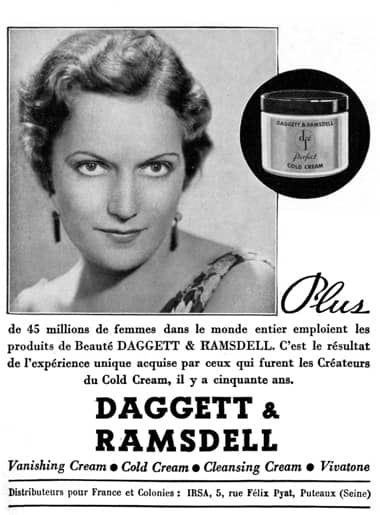
1934 Daggett & Ramsdell as sold in France.
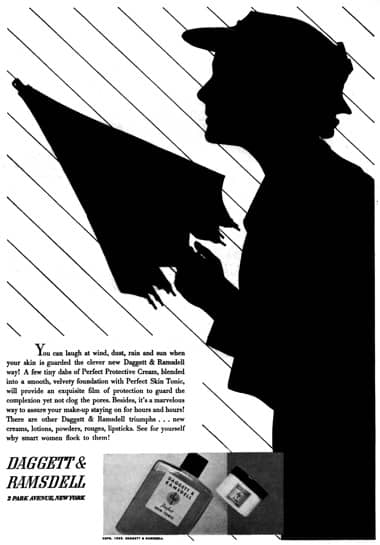
1935 Daggett & Ramsdell Perfect Skin Tonic and Perfect Skin Food.
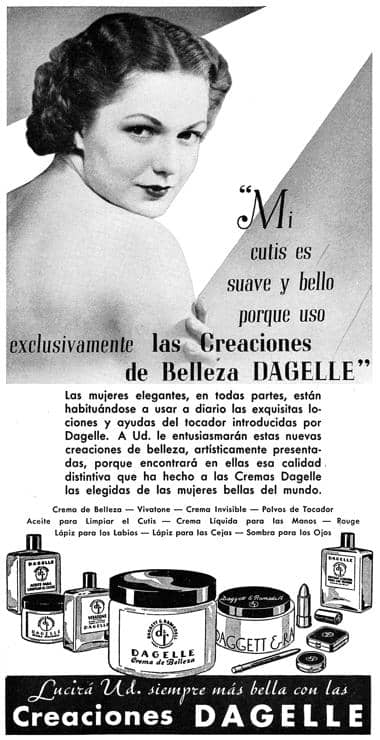
1936 Creaciones Dagelle. Daggett & Ramsdell sold its products under the Dagelle brand in Mexico, Central and South America.
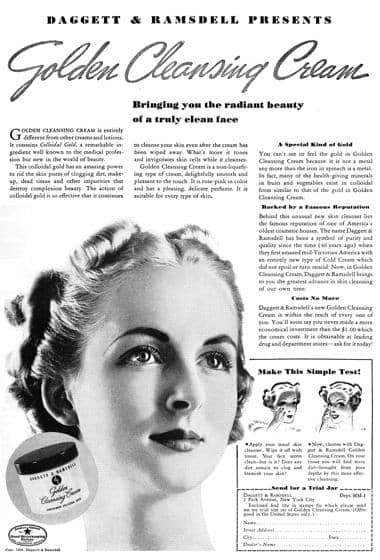
1936 Daggett & Ramsdell Golden Cleansing Cream.
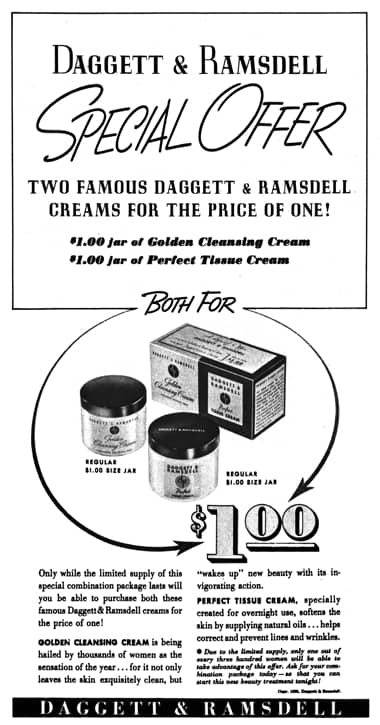
1938 Daggett & Ramsdell Golden Cleansing Cream and Perfect Tissue Cream
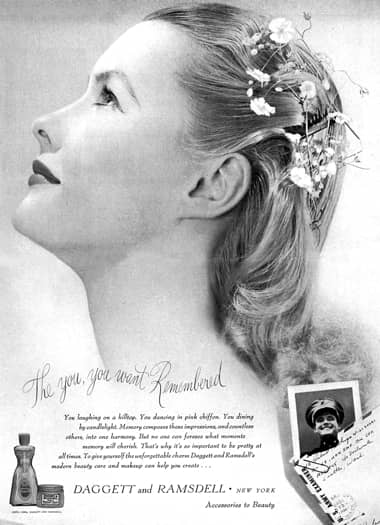
1944 Daggett & Ramsdell Protective Lotion and Deodorant Cream.
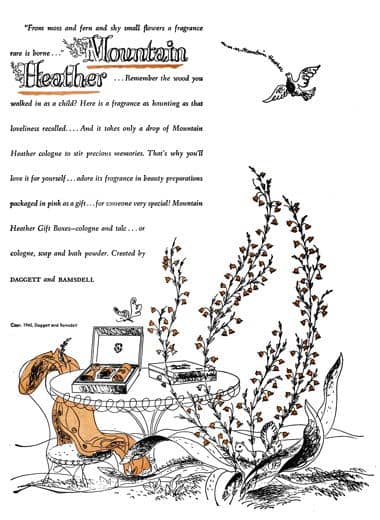
1945 Daggett & Ramsdell Mountain Heather.
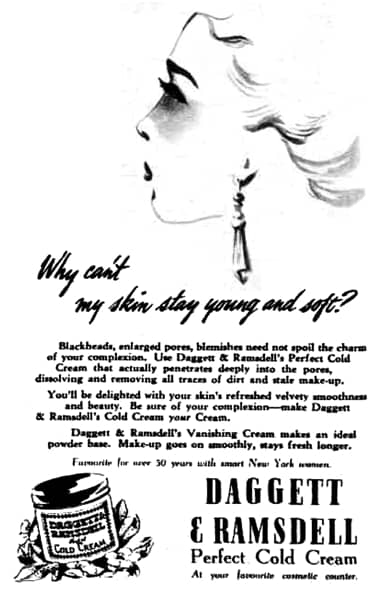
1947 Daggett & Ramsdell Cold Cream as sold in Australia.
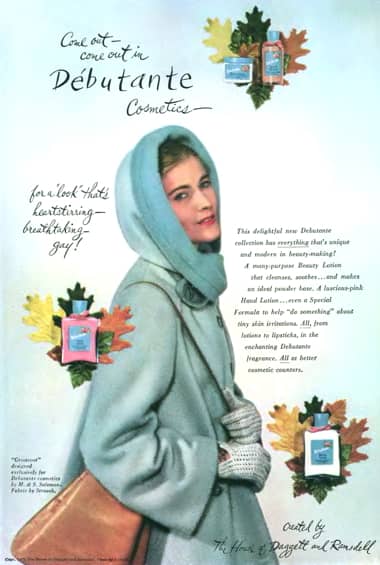
1947 Daggett & Ramsdell Débutante.
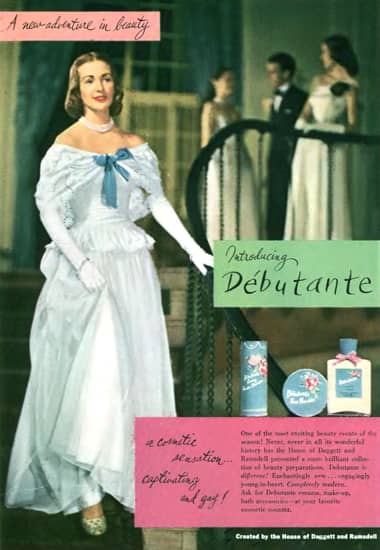
1947 Daggett & Ramsdell Débutante.
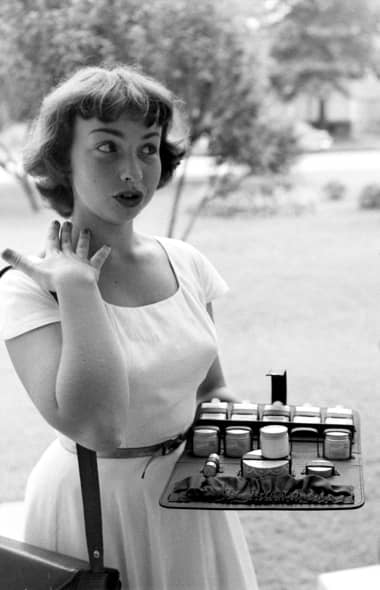
1948 A Fullerette from the Fuller Brush Company selling Daggett & Ramsdell Débutante cosmetics door-to-door (LIFE). The Fullerettes paid US$9.50 for a shoulder bag of samples and 2¢ for each free lipstick they gave away.

Poster for the ‘Fuller Brush Girl’ by Columbia Pictures (1950). This was the second movie the studio made about Fuller Brush the first being ‘The Fuller Brush Man’ (1948).
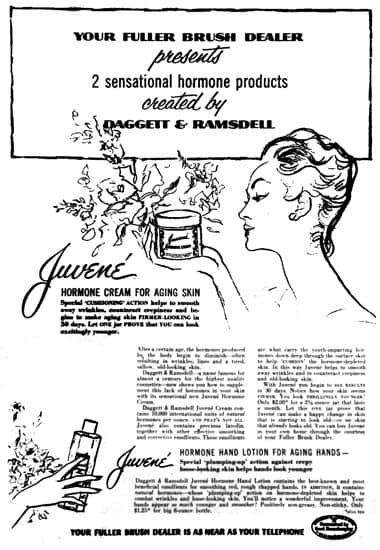
1954 Juvené Hormone Cream and Hormone Hand Lotion.
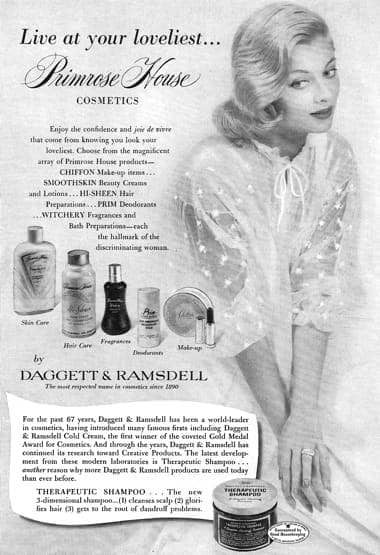
1957 Primrose House products as sold by Daggett & Ramsdell. The Therapeutic Shampoo mentioned is a Daggett & Ramsdell line.
